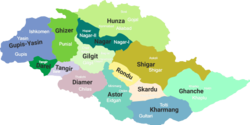Astore District
Astore District
ضلع استور | |
|---|---|
1998) | |
| • Total | 71,666 |
| Number of tehsils | 2 |
Astore District (


Astore Valley

The Astore Valley has an area of 5,092 km2 and lies at an altitude of 2,600 metres (8,500 ft). The valley has approximately 250 square kilometres (97 sq mi) of glacier cover.[3] The nearest glacier after entering the valley is the Harcho Glacier,[4] and the most accessible is the Siachen Glacier.[5]
Accessibility
Eidgah is connected to Gilgit, which is well connected by air with
History
Around 1600, according to the
Ghāzī Mukhpun, a Persian adventurer, is said to have married a princess of the Skārdu reigning family. The four sons born of this union became Rās of Astor, Kharmang, Rondu, and Skārdu, respectively, and from them are descended the families of the present chiefs of those places. The independence of Astor ceased with the Dogra conquest.[8]
References
- ^ due weightin the coverage. Although "controlled" and "held" are also applied neutrally to the names of the disputants or to the regions administered by them, as evidenced in sources (h) through (i) below, "held" is also considered politicized usage, as is the term "occupied," (see (j) below).
(a) Kashmir, region Indian subcontinent, Encyclopaedia Britannica, retrieved 15 August 2019 (subscription required) Quote: "Kashmir, region of the northwestern Indian subcontinent ... has been the subject of dispute between India and Pakistan since the partition of the Indian subcontinent in 1947. The northern and western portions are administered by Pakistan and comprise three areas: Azad Kashmir, Gilgit, and Baltistan, the last two being part of a territory called the Northern Areas. Administered by India are the southern and southeastern portions, which constitute the state of Jammu and Kashmir but are slated to be split into two union territories.";
(b) Pletcher, Kenneth, Aksai Chin, Plateau Region, Asia, Encyclopaedia Britannica, retrieved 16 August 2019 (subscription required) Quote: "Aksai Chin, Chinese (Pinyin) Aksayqin, portion of the Kashmir region, at the northernmost extent of the Indian subcontinent in south-central Asia. It constitutes nearly all the territory of the Chinese-administered sector of Kashmir that is claimed by India to be part of the Ladakh area of Jammu and Kashmir state.";
(c) "Kashmir", Encyclopedia Americana, Scholastic Library Publishing, 2006, p. 328,ISBN 978-1-84904-621-3Quote:"Some politicised terms also are used to describe parts of J&K. These terms include the words 'occupied' and 'held'." - ^ "GB notifies four more districts, total number of districts now 14". Pakistan Today.
- ^ Sher Muhammad, Lide Tian, Asif Khan, "Early twenty-first century glacier mass losses in the Indus Basin constrained by density assumptions", Journal of Hydrology, Volume 574, 2019, pages 467–475
- ^ Muhammad, S., Tian, L., & Nüsser, M. (2019). "No significant mass loss in the glaciers of Astore Basin (North-Western Himalaya), between 1999 and 2016". Journal of Glaciology, 65(250), 270–278. doi:10.1017/jog.2019.5
- ^ Muhammad, S. and Tian, L. (2016) Changes in the ablation zones of glaciers in the western Himalaya and the Karakoram between 1972 and 2015, Remote Sensing of Environment. Elsevier Inc., 187, pp. 505–512. doi: 10.1016/j.rse.2016.10.034.
- ^ "Distance from Skardu via Deosai Plains". Google Maps. Retrieved 4 August 2019.
- ^ "Distance from Gilgit via Jaglot". Google Maps. Retrieved 4 August 2019.
- ^ "Gilgit" - Imperial Gazetteer of India, v. 12, p. 239 According to the Imperial Gazetteer, which was compiled in the first decade of the twentieth century, the marriage took place over three hundred years previously.

